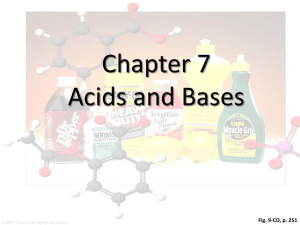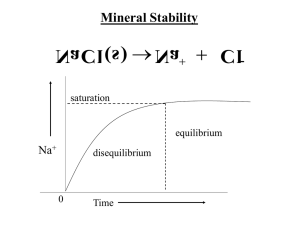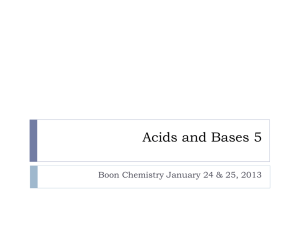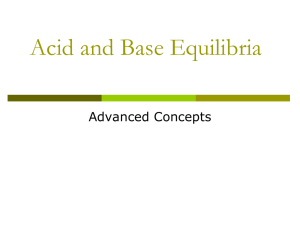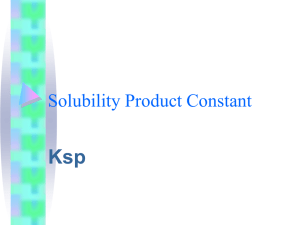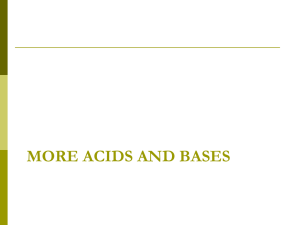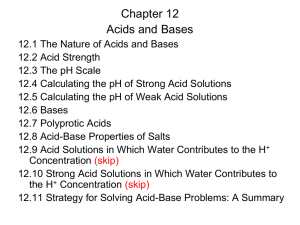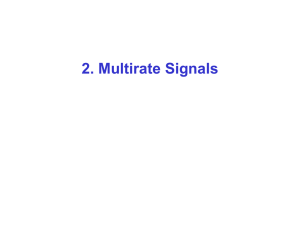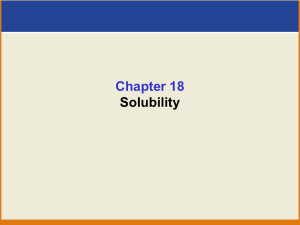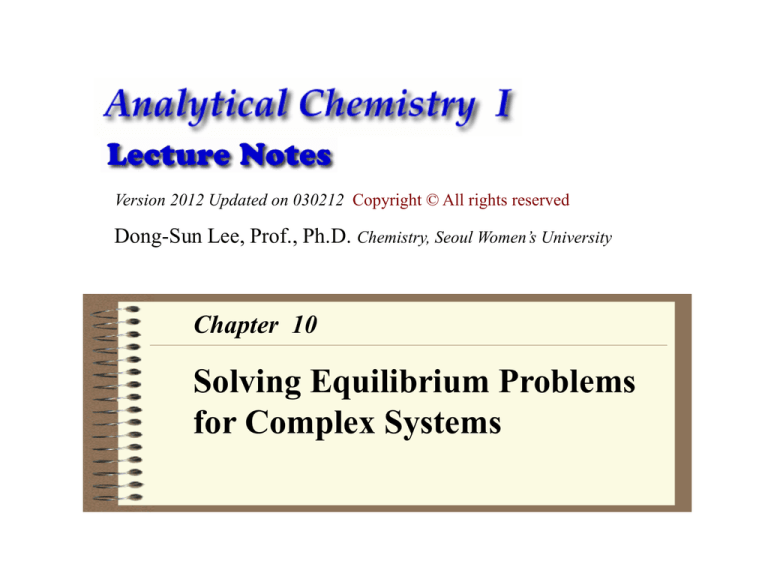
Version 2012 Updated on 030212 Copyright © All rights reserved
Dong-Sun Lee, Prof., Ph.D. Chemistry, Seoul Women’s University
Chapter 10
Solving Equilibrium Problems
for Complex Systems
Erosion of carbonate stone by acid rain. The column at the left is exposed only to
air inside a monument. The column at the right is exposed to acidic rainfall that is
slowly dissolving the marble.
CaCO3 Ca2+ + CO32–
CO32– + H+ HCO3–
Mass balance ; material balance
The sum of the amounts of all species containing a particular atom (or group of
atoms) must equal the amount of that atom (or group) delivered to the solution.
The mass balance is a statement of the conservation of matter. It really refers to
conservation of atoms, not to mass.
Ex. 1) 0.050 mol of acetic acid in water 1L solution
CH3COOH = CH3COO– + H+
mass balance : 0.050M = [CH3COOH] + [CH3COO– ]
2) Aqueous solution of La(IO3) 3
La(IO3) 3 = La3 + + 3 IO3–
initial
solid
0
0
final
solid
x
3x
mass balance : [IO3–] = 3 [La3 +]
Ex. 3) 0.0100 M HCl + excess solid BaSO4
Three equilibria :
BaSO4(s) Ba2+ + SO42–
SO42– + H3O+ HSO4– + H2O
2H2O H3O+ + OH–
Because the only source for the two sulfate species is the dissolved
BaSO4, the barium ion concentration must equal the total concentration of
sulfate containing species.
Mass-balance equation:
[Ba2+] = [SO42–] + [HSO4–]
The hydronium ions in the solution can exist either as free H3O+ ions or
combined with SO42– to form HSO4–. These hydronium ions have two
sources: HCl and the dissociation of water.
[H3O+] + [HSO4–] = cHCl + [OH–] = 0.0100 + [OH–]
Charge balance
The charge balance is an algebraic statement of electroneutrality of the
solution. That is the sum of the positive charges in an electrolyte solution
equals the sum of the negative charges in solution.
Solution must have zero total charge.
no. mol/L positive charge = no. mol/L negative charge
[positive charges] = [negative charges]
The general form of the charge balance for any solution:
n1[C1] + n2[C2] + … = m1[A1] + m2[A2] + ...
where ni = charge of the ith cation
[Ci] = concentration of the ith cation
mi = charge of the ith anion
[Ai] = concentration of the ith anion
Ex. 1. Charge balance of a solution containing
H+, OH–, K+, H2PO4–, HPO42–, PO43–
+
+
–
–
2–
3–
[H ] + [K ] = [OH ] + [H2PO4 ] + 2[HPO4 ] + 3[PO4 ]
Ex. 2. Charge balance of a solution containing
H2O, H+, OH–, ClO4–, Fe(CN)63–, CN–, Fe3+, Mg2+, CH3OH, HCN, NH3, NH4+
[H+] + 3[Fe3+] + 2[Mg2+] + [NH4+] = [OH–] + [ClO4–] + 3[Fe(CN)63–] + [CN–]
Neutral species (H2O, CH3OH, HCN, and NH3) do not appear in the charge balance.
Ex. 0.010 M NH3 solution saturated with AgBr
Pertinent equilibria:
AgBr(solid) Ag+ (aq) + Br– (aq)
Ag+ (aq) + 2NH3 (aq) Ag(NH3)+
(aq)
Ag(NH3)+ + NH3 Ag(NH3)2+
NH3 + H2O NH4+ + OH–
2H2O H3O+ + OH–
Mass balance equations:
[Ag+] + [Ag(NH3)+] + [Ag(NH3)2+] = [Br–]
cNH3 = [NH3] + [NH4+] + [Ag(NH3)+] + [Ag(NH3)2+] = 0.010
[OH–] = [NH4+] + [H3O+]
Charge balance :
[Ag+] + [Ag(NH3)+] + [Ag(NH3)2+] + [NH4+] + [H3O+] = [OH–] + [Br–]
Systematic steps for solving problems involving
several equilibria
1.Write balanced chemical equations for all pertinent equilibria.
2.Define the unknown.
3.Write all equilibrium-constant expressions.
4.Write mass balance expressions
5.Write the charge balance expression
6.Count the number of independent equations and unknowns
7.Make approximations
8.Solve the equations
9.Check the assumptions.
Ex. Calculate the molar solubility of Mg(OH)2 in water.
1. Mg(OH)2 (solid) Mg+2 (aq) + 2OH– (aq)
2H2O H3O+ + OH–
2. Solubility Mg = [Mg+2]
3. Ksp = [Mg+2][OH–]2 = 7.1 10–12
Kw = [H3O+][OH–] = 1.0 10–14
4. Mass balance : [OH–] = 2[Mg+2] + [H3O+]
5. Charge balance: [OH–] = 2[Mg+2] + [H3O+]
6. Three independent algebraic equations and three unknowns
7. Ksp of Mg(OH)2 is relatively large: [H3O+] << [OH–] 2[Mg+2] [OH–]
8. Ksp = [Mg+2][OH–]2 = [Mg+2](2[Mg+2])2 = 7.1 10–12
[Mg+2] = {(7.1 10–12) /4}1/3= 1.21 10–4
9. Validation: [OH–] 2[Mg+2] = 2 1.21 10–4
[H3O+] =(1.0 10–14) / (2 1.21 10–4) = 4.1 10–11
Systematic treatment of equilibrium
General prescription :
Ex. Ionization of water
Step 1. Write all the pertinent
1. H2O = H+ + OH–
chemical reactions.
Step 2. Write the charge balance.
2. [H+ ] = [OH–]
Step 3. Write the mass balance.
3. [H+ ] = [OH–]
Step 4. Write the equilibrium
4. Kw = [H+ ]f[OH–]f = 1.0 ×10–14
constant for each chemical
reaction.
5. Two equations, two unknowns
Step 5. Count the equations and
unknowns.
By working with n equations and n
unknowns, the problem can be solved.
Step 6. By hook, or by crook,
solve all the unknowns.
6. [H+ ]f[OH–]f
= [H+ ](1)[H+](1)= 1.0 × 10–14
[H+ ] = 1.0 × 10–7
pH = – logA H+ = – log [H+ ] f= 7.00
Solubility of mercurous chloride
Step 1. Hg2Cl2 = Hg22+ + 2Cl– , H2O = H+ + OH–
Step 2. [H+ ] + 2 [Hg22+] = [Cl–] + [OH–]
Step 3. [Cl–] = 2[Hg22+]
Step 4. Ksp = [Hg22+][Cl–]2 = (x)(2x)2 = 4x3 =1.2 × 10-18
Kw = [H+ ][OH–] = 1.0 × 10–14
Step 5. Four equations, four unknowns
Step 6. [H+] = [OH–] = 1.0 × 10–7
Ksp = [Hg22+][Cl–]2
= [Hg22+](2 [Hg22+])2 = 1.2 × 10-18
[Hg22+] = x =[(1.2×10-18)/4]1/3 = 6.7 × 10-7 M
[Cl–] = 2 x = 1.34 × 10-6 M
Hydronium ion concentrations of weak acids
HA = A– + H+
Dissociation equilibria :
Case Major supplier Necessary
of H +
condition
1
Weak acid
KaF >> Kw
H2O = H+ + OH–
2
Both
KaF = Kw
Charge balance :
[H+] = [A–] + [OH–]
3
Water
KaF << Kw
Mass balance :
F = [HA] + [A–]
initial
F
0
final
F–x
x
Dissociation equilibria constants :
0
x
Ka = [A–][H+] / [HA]
Kw = [H+][OH–]
Four equarions, four unknowns
If the acid dissociation is much greater than the water dissociation, [A–] >>[OH–],
[A–] [H+] = x
Ka = [A–][H+] / [HA] = (x)(x) / (F –x)
(F –x) Ka = x2
x2 + Kax – KaF = 0
x =( – Ka±Ka2 –4KaF) / 2
If assume F >>x ,
F –x F .
x2 / (F –x) x2 / F = Ka
x = [H+] = KaF
Key points
When F/Ka>>103
relative error 1.6%
Dissociation equilibria :
HA = A– + H+
initial
F
0
0
final
F–x
x
x
H2O = H+ + OH–
Charge balance :
[H+] = [A–] + [OH–]
Mass balance :
F = [HA] + [A–]
Dissociation equilibria constants :
Ka = [A–][H+] / [HA]
Kw = [H+][OH–]
Four equations, four unknowns
Ka = [A–][H+] / [HA] = ([H+] –[OH–])[H+] / (F –[H+] + [OH–] )
KaF – Ka[H+] + Ka[OH–] = [H+]2 – [OH–][H+]
[H+]2 + Ka[H+] – (Kw + KaF + KaKw/ [H+] )= 0
[H+] = { – Ka + Ka2 + 4 (Kw + KaF + KaKw/ [H+] )} / 2
Weak bases
Dissociation equilibria :
BH+ + OH–
B + H2O =
initial
F
0
0
final
F–x
x
x
H2O = H+ + OH–
Charge balance :
[BH+ ] + [H+] = [OH–]
Mass balance :
F = [B] + [BH+]
Dissociation equilibria constants :
Kb = ABH+ AOH– /AB [BH+] [OH–] / [B]
Kw = [H+][OH–]
Four equarions, four unknowns
Kb = [BH+] [OH–] / [B] = (x)(x) / (F –x)
(F –x) Kb = x2
x2 + Kbx – KbF = 0
If assume F >>x ,
F –x F .
x2 / (F –x) x2 / F = Kb
x = [OH–] = (– Kb+Kb2 +4KbF) / 2
x = [OH–] = KbF
Key points
[H+] = Kw / [OH–] = Kw / KbF = Kw / (KwF /Ka) = (KwKa/F)
The effect of pH on solubility
Molar solubility of calcium oxalate at pH = 4.00
Step 1. CaC2O4 Ca2+ (aq) + C2O42 – (aq)
H2C2O4 + H2O H3O+ + HC2O4–
HC2O4– + H2O H3O+ + C2O42 –
2H2O = H3O+ + OH–
Step 2. Solubility = [Ca2+]
Step 3. Ksp = [Ca2+][C2O42 –] = 1.7 × 10–9
H2C2O4
Ka1 = [H3O+][HC2O4–] / [H2C2O4] = 5.60 × 10–2
Ka2 = [H3O+][C2O42 –] / [HC2O4– ] = 5.42 × 10–5
Kw = [H3O+][OH–] = 1.0 × 10–14
Step 4. Mass balance : [Ca2+] = [C2O42 –] + [HC2O4– ] + [H2C2O4] = solubility
if pH = 4.00
[H3O+] = 1.00 × 10–4
Step 8. [HC2O4– ] = [H3O+][C2O42 –] / Ka2
=(1.00 ×10–4)[C2O42 –] / (5.42 × 10–5) = 1.85 [C2O42 –]
[H2C2O4] = [H3O+][HC2O4–] / Ka1 = [H3O+](1.85 [C2O42 –]) / Ka1
= (10–4) × (1.85 × [C2O42 –]) / 5.60 × 10–2
= 3.30 × 10–3 × [C2O42 –]
[Ca2+] = [C2O42 –] + [HC2O4– ] + [H2C2O4]
= [C2O42 –] + 1.85 [C2O42 –] + 3.30 × 10–3 [C2O42 –]
= 2.85 [C2O42 –]
or [C2O42 –] = [Ca2+] / 2.85
Ksp = [Ca2+][C2O42 –] = [Ca2+][Ca2+] / 2.85 = 1.7 × 10–9
[Ca2+] = solubility = (2.85 × 1.7 × 10–9)1/2
= 7.0 × 10–5
Dependence of solubility on pH
Solubility of CaF2
Step 1. CaF2 = Ca2+ + 2F– , F– + H2O = HF + OH– , H2O = H+ + OH–
Step 2. [H+ ] + 2[Ca2+] = [OH–] + [F–]
Step 3. [F–] + [HF] = 2[Ca2+]
Step 4. Ksp = [Ca2+][F–]2 = (x)(2x)2 = 4x3 = 3.9×10-11
Kb = [HF][OH–] / [F–]= 1.5 ×10-11,
Kw = [H+ ][OH–] = 1.0 ×10–14
Step 5. Five equations, five unknowns
Step 6. If pH=3.00 [H+] = 1.0 ×10–3 ,
[OH–] = Kw/ [H+ ] = 1.0 ×10–14 / 1.0 ×10–3 = 1.0 ×10–11
Kb = [HF][OH–] / [F–] [HF] = [F–] Kb / [OH–]
= 1.5 ×10-11 [F–] / 1.0 ×10–11 = 1.5 [F–]
[F–] + [HF] = 2[Ca2+] [F–] + 1.5[F–] = 2[Ca2+] [F–]=0.80[Ca2+]
Ksp = [Ca2+][F–]2 = [Ca2+](0.80[Ca2+] )2 = 3.9×10-11
[Ca2+] = 3.9×10-4 M
(left) Transmission electron micrograph of normal human tooth enamel, showing crystals
of hydroxyapatite. (right) Decay enamel, showing regions where the mineral dissolved in
acid.
Tooth enamel contains the mineral hydroxyapatite, a calcium hydroxyphosphate. This
slightly soluble mineral dissolves in acid, because both phosphate and hydroxyl ions react
with hydrogen ion.
Ca10(PO4)6(OH)2 (s) 10Ca2+ + 6 H2PO4– + 2H2O
Decay causing bacteria that adhere to tooth produce lactic acid { CH3CH(OH)COOH }
by metabolizing sugar. Lactic acid lowers the pH at the surface of the tooth below 5.
Fluoride inhibits tooth decay because it forms fluoroapatite {Ca10(PO4)6F2 } which is less
soluble and more acid resistant than hydroxyapatite.
Solubility of precipitates in the presence of complexing agents
Al(OH)3 (solid) Al+3 (aq) + 3(OH)3– (aq)
Al+3 (aq) + 6F– (aq) AlF6–3 (aq)
soluble complex
AgCl (solid) AgCl (aq)
AgCl (aq) Ag+ + Cl–
AgCl (solid) + Cl– AgCl2–
AgCl2– + Cl– AgCl32–
–
The effect of [Cl ] on the solubility of AgCl.
Solubility of Sulfide (example : HgS )
Step 1. HgS = Hg2+ +S2– ,
S2– + H2O = HS– + OH– ,
HS– + H2O = H2S + OH– ,
H2O = H+ + OH–
Step 2. 2[Hg2+ ] + [H1+] = 2[S2–]+[HS–]+[OH–]
Step 3. [Hg2+ ] = [S2–]+[HS–]+[H2S]
Step 4. Ksp =[ Hg2+][S2–] = 5 ×10-54
Kb1 = [HS–][OH–] / [S2 –] = 0.80,
Kb2 = [H2S][OH–] / [HS–]= 1.1 ×10-7,
Kw = [H+ ][OH–] = 1.0 ×10–14
Step 5. six equations, six unknowns
Step 6. If pH=8.00 [OH–] = 1.0 ×10–6 ,
[H2S]= Kb2 [H2S] / [OH–] = 0.11 [HS–]
[HS–]= Kb1 [S2 –] / [OH–] =8.0 ×105 [S2 –]
[Hg2+ ] = [S2–]+[HS–]+[H2S]
= [S2–]+ 8.0 ×105 [S2 –]+0.11 × 8.0 ×105 [S2 –]
=(8.88 ×105 [S2 –]
Ksp = [Hg2+][S2 –] = [Hg2+]{[Hg2+]/ (8.88 ×105 )}= 5 ×10-54
[Hg2+] = 2.1×10–24 M
H2S is colorless, flammable gas with
important chemical toxicological
properties. Its noxious odor of rotten
eggs permit its detection at extremely
low concentration (0.02 ppm).
Because the olfactory sense is dulled
by its action, however, higher
concentrations may be tolerated, and
the lethal concentration of 100 ppm
may be exceeded.
Sulfide ion concentration as a
function of pH in a saturated H2S
solution.
Summary
Mass balance
Charge balance
Systematic calculation of equilibria
The effect of pH on solubility
Solubility of precipitates in the presence of complexing agents
Solubility of Sulfide

